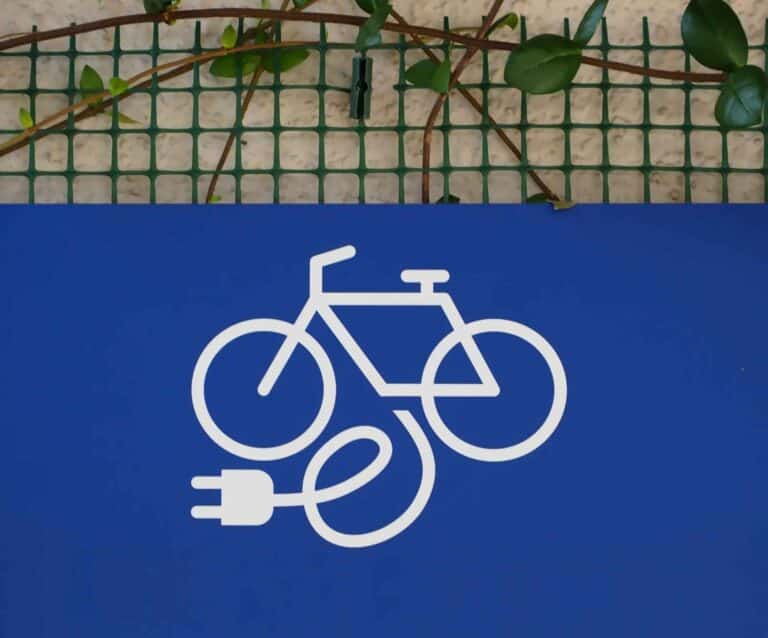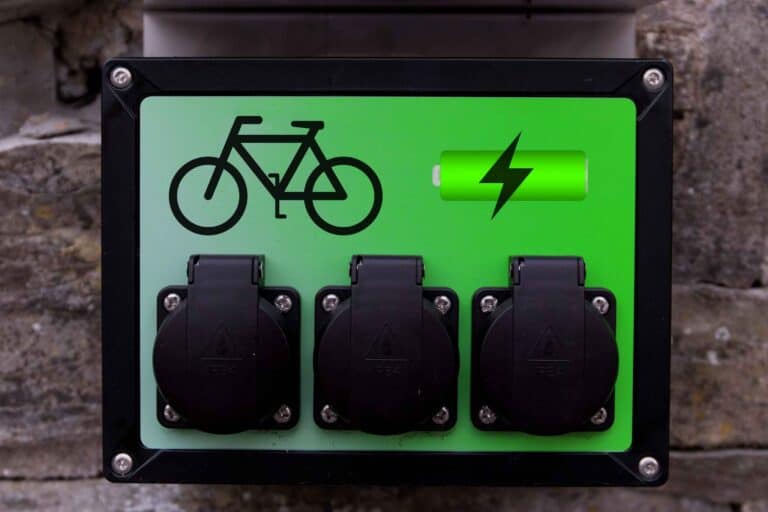Which 18650 Battery Is Best For Your Ebike (A Helpful Chart)
Last week, my friend asked for some help buying a 18650 battery for his electric bike, so we visited different online shops. In the end, after scrolling up and down, he chose the 18650 battery, which he thought was the best. So now, I’ll share which 18650 battery is best for your electric bike.
Samsung INR18650-35E is the best 18650 battery for an electric bike if you are looking for a battery with a high nominal capacity. Samsung INR18650-35E battery has a nominal capacity of 3500 mAh. Having a high capacity ensures that the 18650 battery will last a more extended amount of time.
The battery is among the significant components of an electric bike. Of course, everyone wants to use a high-quality battery, and picking the best 18650 battery can make a huge difference in your ride experience. Later in this post, I’ll share a chart that will break down multiple 18650 batteries, their nominal capacities, and the number of life cycles they will last.
Samsung INR18650-35E Has the Highest Nominal Capacity of 18650 Batteries
As a whole, the Samsung INR18650-35E battery has the highest nominal capacity of the 18650 batteries listed in the included chart below. A higher nominal capacity means the Samsung INR18650-35E battery can store more energy, resulting in higher battery life.
Furthermore, Samsung INR18650-35E takes 500 cycles to reach 60% of standard capacity. Therefore, it means that it will take 500 complete charge and discharge cycles before Samsung INR18650-35E reduces its performance to 60% of its maximum capacity.
Samsung INR18650-35E also has an 8.0A maximum current which you could continuously discharge from this battery.
Samsung INR18650-35E is not the only 18650 battery in the market with this high of a nominal capacity. However, this isn’t the only factor to consider when choosing a 18650 battery. You can always select a 18650 battery that suits your electric bike and its needs.
How To Pick The Best 18650 Battery For Your Electric Bike?
As a whole, to pick the best 18650 Battery for your electric bike, you need to choose one that has a sizeable nominal capacity and a high cycle life. Furthermore, you have to ensure that the 18650 battery you choose is compatible with your electric bike.
A 18650 battery is a battery cell with a rechargeable lithium-ion battery. There are high-quality 18650 batteries that you can find in the market. Most high-quality 18650 batteries are made by leading and trusted manufacturers like Samsung, LG, Molicel, Sony, Sanyo, Panasonic, and Morata.
I created the table below containing different 18650 battery models for electric bikes. I compared their nominal capacity, voltage, standard charge, maximum charge and discharge, allowable environment temperature, and cycle life.
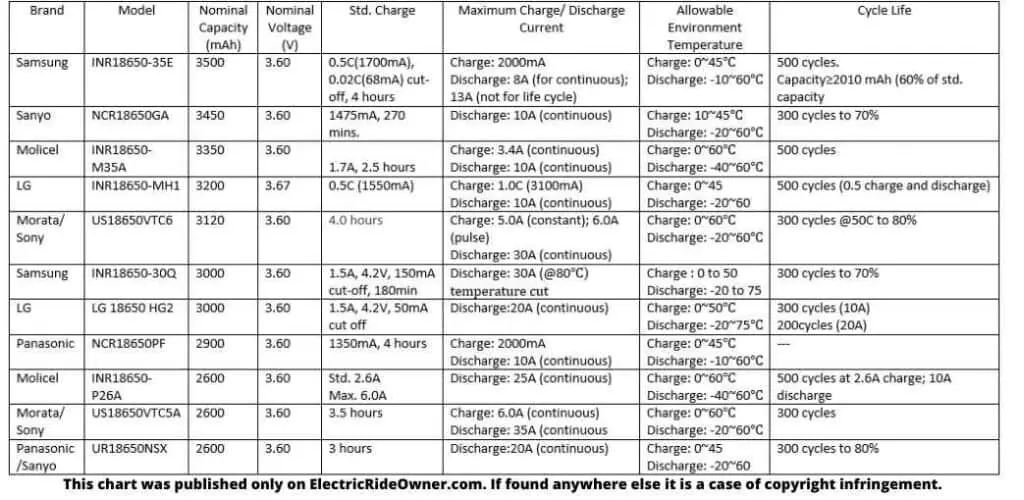
Always Do Your Due Diligence Before Selecting a 18650 Battery
If you have a battery on your mind, you can visit here to check the battery’s information. Just a reminder, always check if the dealer or the manufacturer of the battery is trustworthy because some dealers and shops tend to fake battery ratings for the sake of higher sales.
Keep in mind, a single 18650 battery cell alone cannot be used in an electric bike. Therefore, a certain number of 18650 battery cells are packed together as an electric bike battery.
These battery packs use PCB (Protection Circuit Board), BMS (Battery Management System), and other protective systems to protect the battery pack from potential explosion and damage.
Some manufacturers sell 18650 battery packs, and some companies pack 18650 batteries of your choice. You can also create a 18650 battery pack on your own. If you are a DIY enthusiast, Instructables share steps in making battery packs.
The steps are clearly defined and easy to follow, so you will not have difficulty following them. However, suppose you only know the basics about 18650 batteries and how they work.
In that case, it is advisable to buy a pre-packed battery pack. Remember, safety should always come first.
“A battery by definition is a collection of cells. So the cell is a little can of chemicals. And the challenge is taking a very high-energy cell, and a large number of them, and combining them safely into a large battery.”
—Elon Musk
Are All 18650 Batteries The Same?
As a general rule, all 18650 batteries are not the same. The 18650 batteries are built differently according to specific uses and voltage. Therefore, there are different types from which you can choose.
The 18650 battery cells differ in their sizes, voltage capacity, charge and discharge rate, and other specifications. The reason why they are not built equally is for you to have choices to match your electric bike’s requirements.
This way, you can choose the most compatible 18650 batteries for your e-bike.
Are There Different Types Of 18650 Batteries?
There are different types of 18650 batteries. In general, protected and unprotected batteries are the two main types of 18650 batteries. As the name suggests, a protected 18650 battery has a protective electronic circuit while an unprotected 18650 battery doesn’t.
Protected batteries have an electronic circuit that protects the battery from short circuits, overcharging, and over-discharging. This protective electronic circuit will automatically disconnect if it notices that the battery’s temperature and current do not fall under the normal range.
On the other hand, unprotected 18650 batteries do not have a protective electronic circuit. It means unprotected 18650 batteries are prone to overcharging, over-discharging, and short circuits.
However, unprotected 18650 batteries are cheaper than protected 18650 batteries.
Most people say unprotected 18650 battery cells are more suitable for building 18650 battery packs for electric bikes. But, the packs should use BMS and other protective components. Though protected 18650 batteries are safer, they are not suitable for every device.
In buying 18650 batteries, device “suitability” is a must.
How Many 18650 Do I Need For 48V?
In total, thirteen 18650 battery cells are needed in a series connection for 48V. The nominal voltage of 18650 lithium-ion battery cells is 3.7V. So, to compute the number of cells required, divide 48V by 3.7V.
To attain the 48V, you need to use thirteen 18650 battery cells connected in a series. These 18650 battery cells should have the same nominal voltage.
So, you have to attach the first cell’s positive terminal to the next cell’s negative terminal and so on with the next cell. This battery pack is called 13S1P because there are 13 cells in the series connection and one cell in parallel.
If you target a specific aH for your battery pack, you must work on your parallel connection. For example, if you have 18650 battery cells with 3.7V and 2.6aH each and want to create a battery pack for 48V and 20aH, you need thirteen 18650 cells in each series to attain 48V.
To compute the number of cells for 20aH, divide 20aH by 2.6aH. With that, you need eight cells in each parallel connection.
To get the total number of 18650 battery cells for 48V and 20ah, multiply the number of cells required in the series to the number of cells needed in parallel. So, 13*8 is 104. Thus, you need one hundred and four 18650 battery cells for a 13S8P battery pack with 48V and 20aH.
Let me show you another example:
7.0V and 6.0aH battery pack from Samsung 18650-30Q battery cells (Nominal Voltage= 3.6V; Nominal Capacity= 3.0aH)
To get 7V, divide seven by 3.6V. Therefore, you need two Samsung 18650-30Q battery cells in each series.
For 6aH, divide six by 3aH. Hence, you need two Samsung 18650-30Q cells in each parallel connection.
To get the total number of battery cells required for the 7V and 6aH battery pack, multiply the number of cells needed in the series to the number of cells required in parallel. Thus, you will need 4 Samsung 18650-30Q battery cells for your battery pack. The pack is called 2S2P.
Always remember to buy protective components for your battery pack.
Are 18650 Batteries Banned?
As a general rule, 18650 Batteries are not Banned. However, Consumer Product Safety Commission (CPSC) warns the consumers not to use or buy loose 18650 battery cells. Unfortunately, this warning causes some people to believe that 18650 batteries were banned.
18650 and other batteries are dangerous and destructive if not handled and used correctly. That is why battery manufacturers provide a manual on safety precautions for handling batteries.
Loose battery cells may have exposed positive and negative terminals. As a result, a short circuit might occur if these terminals contact metal or conductive objects. Short circuits can cause fire, explosion, and physical injuries.
On January 08, 2021, CPSC released a warning for consumers not to use loose 18650 lithium-ion battery cells.
CPSC issued this warning after receiving reports of incidents of fire, explosion, and injuries due to improper usage of 18650 batteries. Check the CPSC newsroom to know more about the warning.
The 18650 battery cells that are unprotected should not be used as a standalone battery. Instead, manufacturers usually use these unprotected 18650 battery cells in building battery packs.
However, some retailers and sellers tend to separate every single cell in battery packs and rewrap and sell them as new batteries.
There have been loose 18650 battery cells sold on different e-commerce platforms. With that, CPSC coordinated with these platforms (Amazon, eBay, Walmart, etc.) to delete the listings of loose 18650 battery cells.
Dealers and sellers should not sell these 18650 battery cells unless protected.
“Safety first is safety always.”
—Charles M. Hayes
Safety Tips In Handling 18650 Batteries
- Never use damaged or loose 18650 battery cells.
- Follow and respect charging and discharging time, current, voltage, and temperature limitations of 18650 batteries.
- Use a suitable charger for your 18650 battery. When charging, do not leave your 18650 battery unattended.
- Keep 18650 batteries away from any metal or conductive objects.
To be safe, never use damaged or loose 18650 battery cells.
Using damaged or loose 18650 battery cells can damage your device and expose you to possible risks. Not only can this be hazardous to your health and well-being, but it can be costly.
If a damaged battery cell releases its internal components, it can damage your electric bike. These damages can quickly add up to hundreds, if not thousands of dollars.
An exploding battery can damage your body. It would be best if you never attempted to use damaged battery cells. You are far better off buying new undamaged 18650 cells.
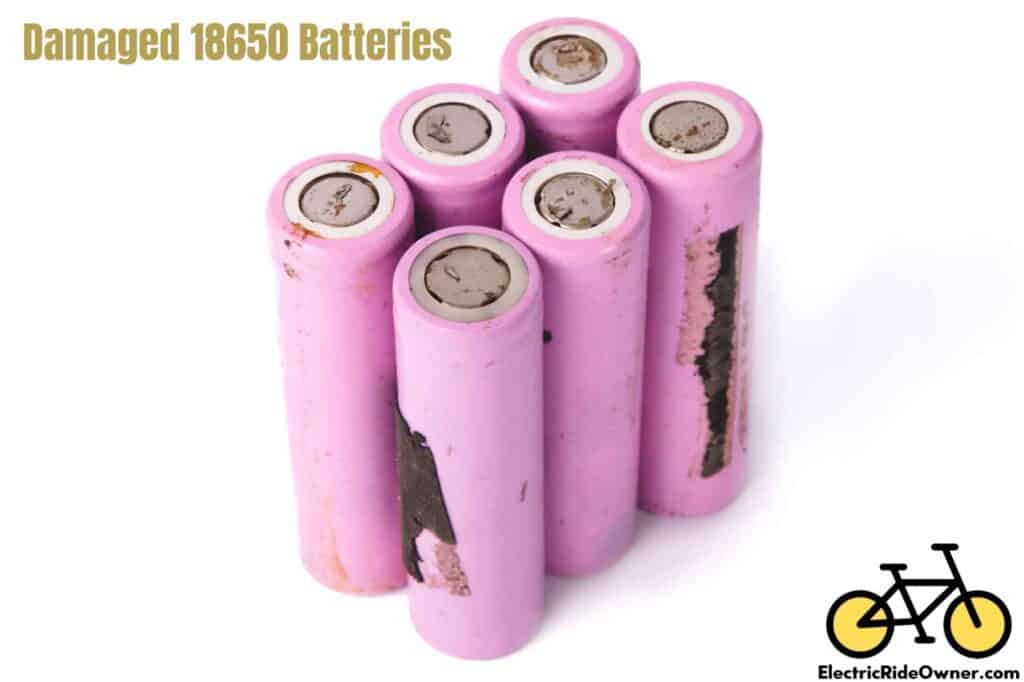
Always follow the charging and discharging time, current, voltage, and temperature limitations of your 18650 battery to avoid possible risks.
Different 18650 battery models do not have the same charging and discharging time, voltage, current, and allowable temperature. Therefore, charging and discharging your batteries within a specified range is necessary. Ensure that the battery is not too high or too low on any particular limitation specification.
When you charge your battery, it is an excellent choice to have a charging timer for you to keep track of the hours left.
Use a suitable charger for your 18650 battery. When charging, do not leave your 18650 battery unattended.
It is essential to keep an eye on your charging 18650 battery to ensure that there will be an immediate response if a hazard occurs unexpectedly.
If you cannot monitor your 18650 battery while it’s charging, wait for a period of time when you can watch it before you attempt to charge it. This can prevent a potentially unfortunate event from occurring.
Keep 18650 batteries away from any metal or conductive objects to avoid short circuits.
Metal elements are good conductors of heat and electricity. A short circuit might occur if a 18650 battery comes in contact with a metal or any conductive object. Therefore, placing your 18650 batteries in a battery case or their original packaging is always better.
These steps apply not only to 18650 batteries but also to all other kinds of batteries as well. To learn more about the safety precautions of your battery, always refer to your battery’s manual.
If you want to know how to store your 18650 battery cells, check this video.
What Is An 18650 Battery Equivalent To?
As a whole, 18650 battery cells are equivalent to 21700 batteries. These batteries are both made from lithium-ion batteries but are produced in different sizes.
The 18650 batteries are similar to 21700 batteries. The typical nominal voltage capacity of these batteries is 3.6V/3.7V. However, their sizes are different.
The 21700 batteries are 21mm X 70mm in size, while the 18650 batteries are 18mm X 65mm in size. When choosing between the two, use the battery size that fits your electric bikes.
What Battery Can I Use Instead of 18650?
As a general rule, you can use 21700, 20700, and 26650 batteries instead of 18650 batteries. These batteries are all made from rechargeable lithium-ion battery cells. As a result, you can use them interchangeably in certain circumstances.
Their sizes are the first noticeable difference between 18650, 21700, 20700, and 26650 batteries. Therefore, these batteries are named after their sizes. The first two numbers are the batteries’ diameters, the next two are their lengths, and the 0 is their cylindrical shapes.
With that, 18650 batteries have a diameter of 18mm and a length of 65mm. The 20700 and 21700 batteries have 20mm and 21mm diameters, respectively. They have the same length of 70mm.
On the other hand, 26650 batteries have 26mm diameter and 65mm length.
18650, 20700, 21700, and 26650 batteries are from rechargeable lithium-ion battery cells. All of these batteries can be protected and unprotected. The 18650, 20700, 21700, and 26650 batteries can also be flat tops and button tops.
Since 20700, 21700, and 26650 batteries are bigger than 18650 batteries, they have larger capacities. The capacity of 18650 batteries ranges from 1200-3600 mAh.
The capacity of 20700 and 21700 batteries range from 3,000 to 5100 mAh, and 26650 batteries can reach up to 10,000 mAh
Because 20700, 21700, and 26650 batteries have higher capacities, they have better run-time. As a result, they are suitable to use for high-drain devices.
These lithium-ion batteries are designed for specific usage. They have different sizes. So, it is essential to know the limitations of your device.
If you are looking for an electric bike battery with either 18650 or 21700 Battery Cells, check out Unit Pack Power e-bike batteries.
Which Battery Is Best For eBike?
On average, lithium-ion batteries are best for an eBike. Lithium-ion batteries are rechargeable batteries that are charged and discharged using lithium-ions. It is a fact that lithium-ion batteries are better for electric bikes than lead-acid batteries and nickel-cadmium batteries.
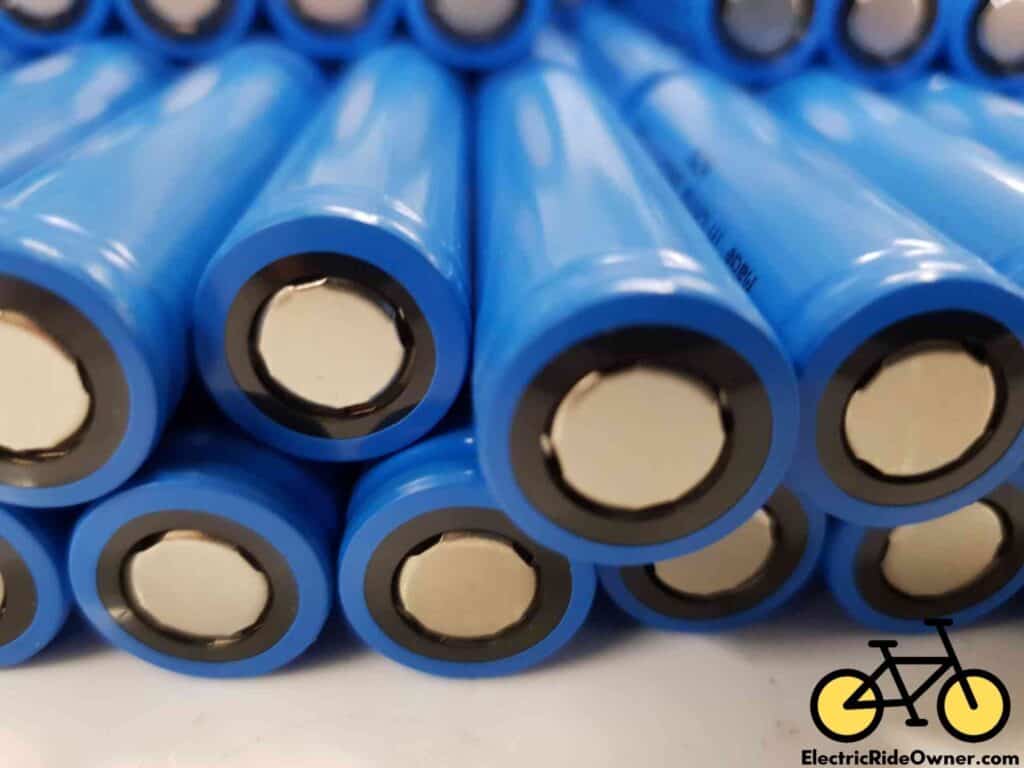
In the past years, electric bikes have used lead-acid and nickel-cadmium batteries. However, as technology changes, e-bike batteries have improved.
Today, most electric bikes use lithium-ion batteries. However, there are still e-bikes that use lead-acid and nickel-cadmium batteries.
Lithium-ion batteries are known for their incredible power, faster charging time, and longer life span. We posted an entire article breaking down how long electric bike batteries last. You can access that article here. On top of that, lithium-ion batteries have excellent durability.
No one wants to use a battery with unsatisfactory performance if given a choice. You should always follow instructions written in the manual and never make a DIY battery if you don’t know anything about batteries.
DIY batteries are good but sometimes dangerous. Do not put yourself in harm’s way. Do extensive research before buying the battery that you have in mind. The more you know, the better!
If you want to learn about different ways of charging your e-bike on the go, check our article, “Charging eBike On The Go (Car Battery, Inverter Power Bank, Solar).”




